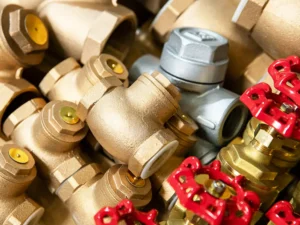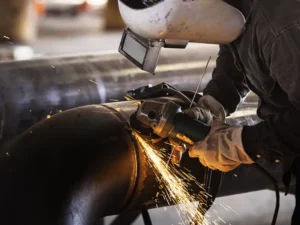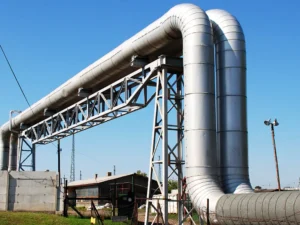
The pipe spool is an advanced approach to constructing and building piping systems. It consists of prefabricated components joined together. Many industries use this to set up complex piping systems. The usage of pipe spools is getting more common.
Understanding pipe spools is crucial if you are involved in construction or piping work. It will help you speed up your piping and drainage system. This guide will explain the pipe spool, its fabrication, and application. Let’s drill into it!
Introduction to Pipe Spool
Imagine a building being constructed in a populated area. It can be in the middle of the city and along the road. Setting up the piping system, welding components, and fabrication will require space. But you don’t have any space for piping fabrication.
In such cases, the pipe spool comes in handy. It comprises pre-built pipes with elbows, tees, flanges, or valves. These components are welded together and are ready to install. The engineer uses such pre-built systems and installs them on the project site.
In this way, engineers won’t have to set up all the pipes and components in the construction site. It saves time and requires no space in the working area. The engineers make the pipe spool in a controlled environment. Once created, they transport the pipe spool to the working site and install it.
I used the example of construction work. The pipe spool is very effective in many situations. These include chemical plants, refineries, pipelines, and offshore platforms. It is also used in the transportation of crude oil and water.
Components of a Pipe Spool
A pipe spool is a collection of smaller pieces that are joined together. But I would consider it a complete system for piping. The reason is that it involves almost all the components that a piping system requires. Here is the list of pipe spool components:
- Pipes: Every pipe spool consists of multiple pipes. They act as significant pillars and transport liquid glasses, etc.
- Elbow & Tees: Both of these are vital components. They are used when changing the direction of pipes is required. If the pipe is straight, and you need a 90-degree angle to the right, these elbows and tees are handy.
- Reducers: They are used when the merging of two pipes is required. They change the diameters of pipes and ensure that the necessary flow of liquid is maintained.
- Couplers and Crosses: Couplers connect two ends of the pipes. If you need a more extended pipe spool, a coupler connects the pipes. The crosses offer multiple branching points in the system to spread the pipes in different directions.
- Flanges: Flat, circular plates that join pipe spools to other spools. They provide a reliable method for connecting and disconnecting sections of the piping system.
- Valve & Hangers: They are used in almost every house. Their purpose is to start, stop, or reduce the fluid flow speed. Apart from these, the hangers are also used in the pipe spool. They are structural elements that stabilize and support the piping system.
All these components are joined together according to needs and requirements. The advantage of the pipe spool is that the attachment of the components is done in a controlled environment. Once ready, they are transported to the actual workplace, where they are installed.
What Is Pipe Spool Fabrication?

Spool fabrication is making and assembling the components to make the pipe spool. It is the process done in controlled or favorable conditions in specialized places. There are different steps involved in the processing of the pipe spool fabrication.
Mainly, it includes joining the pipe spool’s different components. The pipe spool fabrication is considered very cost-effective. Once the fabrication finishes, the pipe spool goes on-site to be installed.
Process of Pipe Spool Fabrication
Fabrication is a complex process. It requires multiple steps to complete. The pipe components are welded and assembled. Follow are the steps that fabricators go through:
- Design and Engineering
- Cutting and Bending
- Assembly and Welding
- Inspection and Testing
- Surface Treatment for corrosion-resistant
All the above steps are vital for successful fabrication. The engineers use two primary methods for making the pipe spools. Those are as follows:
- Spool Roll Fitting and Welding: The rolling machine is used for this method. It rotates the pipe. It becomes more accessible for the workers to weld the pipes from different positions. It ensures safe and reliable pipe spooling.
- Spool Position Fitting and Welding: Machine involvement is minimal in this method of pipe spool fabrication. The workers must move around the pipe and do the fitting and welding process. It is important to note that this process takes longer to complete and is also tiring for the workers.
Almost all the pipe spools get rusty over time. They are not prone to it. Therefore, the manufacturer applies a coat of paint or epoxy. This coating ensures the pipes resist rust, corrosion, and moisture attack.
Pipe Spooling Applications

As I said earlier, the pipe spool fabrication requires time and space. So, all those industries that lack space use pipe spooling. In the section below, I’ll mention some applications of pipe spools.
- The water plants that supply water to different areas also use this method.
- Power plants also use this piping method to transport other fluids.
- The oil, gasses, and petrochemical plants usually use pipe spooling. Almost all the offshore companies use this method. It helps them install the piping system quickly and get the job done.
- The pipe spool is used in the air conditioning (HVAC) systems. Usually, large buildings need more space for on-site line and pipe setup. So, using pipe spooling is suitable.
- All construction work happening in the cities utilizes pipe spooling. It helps the constructors arrange large spaces for piping. The ready-made pipes make their lives easier.
- In marine and mining work, the pipe spool proved to be effective. However, this work requires a resistant and robust piping system. It does not degrade over time due to moisture. Thanks to excellent rust-resistant coating.
Is Pipe Spool Worth it?
Yes, the pipe spool is worth it because it offers a speedy and cost-effective piping solution. It is significantly more suitable for those construction sites that have less space. Its off-site fabrication makes it ideal for large industries.
As I said earlier, the large industries in the populated areas don’t have generous spacing. During construction, they need help installing the piping system due to the lack of on-site space. In such cases, the pipe spool works the magic.
The engineer manufactures or fabricates the pipe spools in the controlled area (off-site). In the meantime, the construction work can be progressive without any issues. Once the job is complete, the pipe spool is installed successfully. It affects construction work or speed.
This is useful not only for construction work but also for a wide range of industries. Those include petroleum, refineries, water plants, and more. But, the fabrication process will need extreme accuracy and precision. Therefore, this work must be done by the experts.
Important Point: The pipes must be accurate in terms of lengths and angles. If they are not perfectly fit or measured, the spool will not fit. Therefore, having precision in mind is critical.
Conclusion
Pipe spools have undoubtedly made lives easier for manufacturers and engineers. They are an easy, cost-effective, and quick method for setting up a piping system. Many modern small to large industries prefer using pipe spooling.
In this guide, I have explained the pipe spool in detail. From its fabrication to application, everything is discussed.
